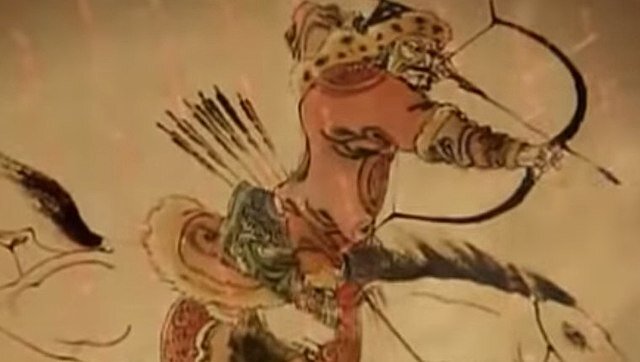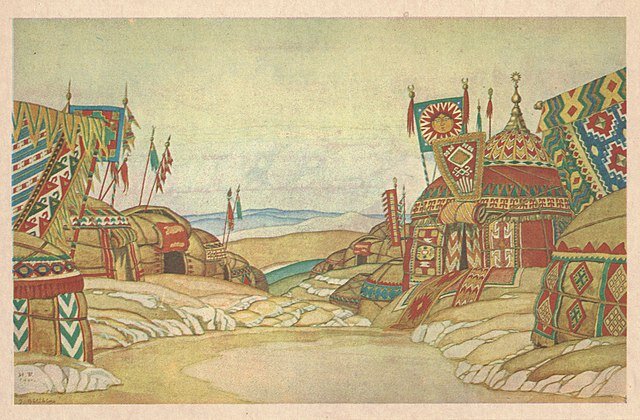As a result of tumultuous events in Central Asia in the eleventh century, the Kipchak people were scattered throughout the regions. A number of Kipchak groups headed eastward. At the beginning of the XI century, the Kipchak tribal association of Tatar-Tzubu fought with the Kidans. This struggle was lost by them and after a split in their clan the head of the tribe Khan Kun-yan in 1000 was killed. Then remnants of this sort have turned in flight and have created on a new dwelling place tribal confederation about which is written the official history of China under the name «Yuan shi».
Yuan scholar and writer Yu Ji so reports about Kipchaks: «Local morals were bold and daring, and their people were brave, so that they knew how to fight perfectly, and the available Kun-yan was the one who then gave the name of their state, called «Kipchak», and became their ruler to rule them».
In 1237, Khan Urusman submitted to the Mongols, and then sent his son Balduchak and his men to meet Mengu Khan. The Mongol khan meanwhile entered the limits of Inasa’s horde — the lands of the Kipchaks. After this meeting Balduchak went on a campaign with Mengu Khan to the Alanian city of Magas in 1239-1240. He became a centurion of the Kipchaks in the Mongolian troops, and this campaign made him famous.
Balduchak entered Mengu Khan’s inner circle, and began to supply the Mongols with «black koumiss,» an invention of the Kipchaks. By 1261 Balduchak had passed away and his son Tutuk succeeded to his duties. During the feud between Yuan Khan Khubilai and Haidu Khan in 1269, Tutuk began to rise through the ranks in the Yuan state.

Map of the Yuan Empire
It is known that in the service of the Yuan dynasty besides Kipchaks were Kangles. They were such chiefs as Asanbuka, Sognak-tegin, Aibai, Abo-bayut. There were about 60 Kipchaks in the commanding staff of the Yuan Empire, which are mentioned by Chinese chroniclers.
The Kipchak commander Sidur entered the service of the Mongols in 1273. He participated in a military campaign against the Southern Song state in 1274. He was then appointed by Khubilai Khan as a centurion in the Emperor’s guard. After Sidur, he was appointed governor of the provinces along the Yangtze River in 1287. He was also directly involved in the military campaign against Vietnam. In Vietnam, Sidur managed to take the fortress of Tsozichen, and participated in many battles and the capture of the Vietnamese capital. Once the Yuan troops in Vietnam were surrounded, but the Kipchak Guards managed to break through the enemy’s ring to retreat.

The flag of the Yuan dynasty. Photo from open sources on the Internet.
Kipchak warrior Ulcheybatur in 1256 was accepted into the army of the Mongols, and then in 1259 together with Mengu Khan took part in a military campaign against the Southern Song state. During the storming of the city of Yezhou, he was one of the first to climb the fortress wall. He also participated in naval battles. For his supreme merits he was later promoted to commander of the tumen and made governor.
In 1274 Kipchak detachments participated in the naval campaign of the Yuan army against Japan. In the battles in Japan then distinguished Kipchak Baitemur. Kipchak cavalrymen then, in particular, shelled Japanese troops.

Scrolls with paintings of Mongol invasions (a copy of a work by an unknown artist dated 1293). Ink and watercolor on paper. Tokyo National Museum. The scrolls recount the Mongol invasions of 1274 and 1281. The photo is in the public domain.
Tutuk with his Kipchak guards successfully suppressed rebellions raised against Khubilai Khan. In 1284 he added to the Kipchak guard and Mongolian detachments. In 1286 the Kipchak guard also included Kangles and Karlukes. After 30 years this guard already had an army of 35 thousand men.
The Mongol khan valued Tutuk very much, and later appointed him commander-in-chief of the defense forces of his state, as well as assistant to the head of the Supreme Military Council Yuan.
Tutuk with his guard often participated in campaigns since the end of 80th years of XIII century. Tutuk’s sons were also able to distinguish themselves in military campaigns. In 1293 Tutuk was promoted to the position of senior commander of the emperor’s guard. After Khubilai’s death, his grandson Temur came to power, who also supported Tutuk and generously rewarded him and the Kipchak guard.

A Mongol warrior on horseback prepares a mounted archery shot. Photo from free sources on the Internet.
Tutuk died in 1297 and his family very confidently took the leading places in the government of the Yuan Empire. Especially Tutuk’s son Chunkur was able to advance in the rule of the Yuan Empire. He married a princess from the royal Yuan family and became a relative of the ruling dynasty. Subsequently, in the 1320s, the Tutuk family became one of the noble and influential in the Yuan Empire.

CUMANS (KIPCHAKS) CAMP. Sketch of the set for the second act of Borodin’s opera «Prince Igor» in 1930. The photo is in the public domain.
After the death of Khan Temur in 1307, the Kipchaks were removed from ruling positions. The Mongol commander of the Yuan army Bayan Baarin began to compete with the Tutuk clan and in 1335 began to persecute the representative of the Kipchak clan Tankish. Under such conditions, the Kipchak influence in the upper reaches of the Yuan Empire weakened. By the 1340s, the Kipchaks began to revolt in the provinces, and by the 1350s they began to oppose the Chinese authority together with the peasants. Spontaneous popular uprisings began to break out in the provinces, in which the Kipchaks actively participated. Kipchaks and Mongols began to be massacred by Chinese troops. However, the Kipchaks still managed to survive in this troubled time.
Later on, the Kipchaks of China began to assimilate gradually and mixed with the local population. By the beginning of the 15th century, some remaining Kipchak groups left China and migrated to the steppe zone and Altai.
